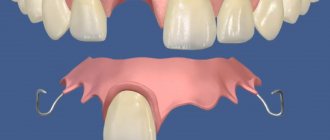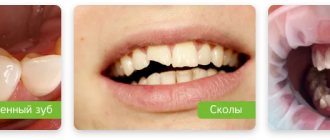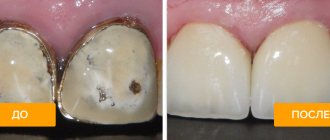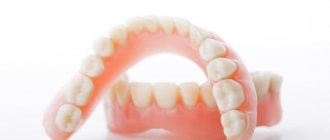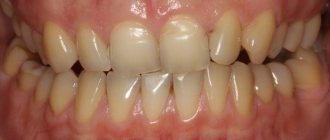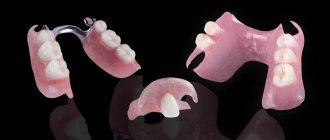Metal-plastic crowns have gained great popularity due to their low price. Typically, restoring chewing functions is quite expensive. Implantation and ceramic prosthetics are not available to everyone. Therefore, a metal frame with a plastic coating is used in all dental clinics as an alternative to expensive treatment.
In some cases, metal-plastic products of this type are used as temporary treatment, which involves the subsequent installation of a prosthesis with a long service life.
Types of metal-plastic crowns
In modern dentistry, metal-plastic dental crowns are divided into two main types. They differ in the manufacturing principle, which is also reflected in the time and material used:
- Cast metal-plastic crowns. These products are the most common, since the resulting structure will be highly durable and of high quality. It involves the doctor making an impression of the teeth, with the help of which prosthetics will be created in the laboratory. The main frame will be made by casting from a material based on a compound of chromium and cobalt. Then a layer of plastic is applied to the surface, completely imitating the color and appearance of natural teeth.
- Stamped metal-plastic crowns. It is assumed that a standard frame will be created. It is coated with plastic in the presence of the patient right in the dentist’s office. Such metal-plastic dental prosthetics has aesthetic and functional disadvantages. But the main advantage of the method is that the manufacturing and installation process can be completed in one step. This allows the use of such prosthetics as an immediate temporary measure.
Experienced dentists themselves will offer you this method of restoring dental function as an alternative if its use is rational. Therefore, the main thing is to choose a specialist who can compare the condition of your teeth with your financial capabilities, without trying to offer more expensive treatment. These are the doctors who work at the Academy Dent clinic.
Features of metal-plastic crowns
The design is based on a metal base. An aesthetic layer of plastic is applied to the surface of the metal crown. This can be a single crown or a structure consisting of several elements - a bridge. In the second case, several crowns are combined together and can replace from one to three teeth in a row.
The design can be stamped or cast. The second option is more reliable and durable. Cast crowns are made from impressions taken from teeth prepared for prosthetics. Unlike stamped crowns, cast crowns allow you to choose the color of the coating and ensure a reliable fit to the tooth stump.
In terms of strength, such crowns are inferior to similar products made from metal ceramics. The problem is the fragility of the plastic. The basis, as a rule, is an alloy of cobalt and chromium. Alloys of precious metals can also be used for this.
PROMOTION
Installation of crowns, dental bridge
RUB 3,450
Stages of manufacturing a metal-plastic crown
Cast metal-plastic crowns are manufactured in the following order:
- diagnostics. The doctor examines the dentition, also checking the supporting teeth. This process usually involves additional hardware research to determine prosthetic options;
- Preparation. At this stage, tooth extraction may be performed. The doctor also grinds the supporting units, removing a layer of up to 2 mm from them. This usually takes place under local anesthesia;
- formation of the model. The dentist takes an impression of the teeth and then casts a model of the oral cavity based on it. In this case, a special plaster is used that can accurately replicate all shapes;
- creation of a prosthesis. Using the received form, the doctor makes a wax model of the tooth with a frame. It will be used for metal casting. The finished product is able to work under high loads without causing allergies in the patient. However, to give it an aesthetic appearance, it is covered with several layers of polymer plastic;
- temporary installation. Metal-plastic crowns are delivered to the dentist’s office in finished form. The doctor coats the teeth with a special compound and attaches the prosthesis to a temporary compound;
- examination. The patient checks the comfort of the installed prostheses, and the doctor can make sure that they comply with the indications;
- permanent installation. If metal-plastic products do not cause discomfort, and the doctor sees no reason for modifications, then prosthetics are performed using cement.
Metal-plastic crowns are usually made in 3 days. Moreover, their fixation takes no more than 15 minutes.
Advantages and disadvantages
Advantages
- Low price
- Restoration of metal-plastic crowns is carried out in the patient’s mouth (for small chips, cracks)
- Do not injure the enamel of opposite, neighboring teeth
- Fast production
- Functionality
- Reliable fixation on an abutment tooth or implant
Flaws
- Short service time
- Insufficient aesthetics (deformed, change color)
- Allergy to plastic, metal alloy
- Insufficient strength (plastic breaks off from the frame and wears off)
- Requires extensive preparation of supporting units
Metal-plastic crowns: indications for installation
Typically, metal-plastic crowns are installed in the following cases:
- missing one or more teeth;
- if necessary, protect the tooth from destruction. Then the unit without the nerve acts as the basis;
- detection of defects in the form of cracks, chips and spalling;
- in the presence of diastemas;
- high abrasion of enamel with increased tooth sensitivity.
This procedure also has its contraindications. There are quite a lot of them, and the doctor first of all studies this list:
- the patient has allergic reactions to metal or plastic;
- observation of abnormal height of the anterior teeth;
- the presence of reversals and torsions;
- identification of all types of periodontitis in severe and even chronic forms;
- vestibular position of teeth;
- bruxism. However, this contraindication can be considered conditional. If the patient uses a special mouth guard while sleeping, this will allow him to use such prostheses without seriously reducing their service life;
- the presence of a pathological bite that has developed to the second and third degrees.
Most of these contraindications are also suitable for other prosthetic methods. Some of them indicate incompatibility with metal-plastic.
You should not decide on your own whether you have indications for this type of prosthetics. This can only be done by an experienced dentist, assessing the individual parameters of the oral cavity and the physical health of the patient.
Examples of work “Before” and “After”
Simultaneous implantation in the lateral sections of the upper and lower jaws
Case: destruction of teeth under the crowns in the lateral sections of the upper and lower jaws.
Restoration of all teeth using basal implantation method (March 2012)
Case: partial adentia, exposed roots of natural teeth, periodontitis, increased tooth mobility, severe atrophy of bone tissue in some places beyond the possible norms for classical dental implantation.
Restoration of chewing teeth - basal implantation (March 2012)
Case: absence of chewing teeth in the lower jaw.
Combined implantation of ROOTT lower jaw
Case: destruction of the frontal group of teeth under the prosthesis, absence of chewing teeth.
Pros and cons of prosthetics with metal-plastic crowns
All metal-plastic crowns have a low price. This is the main advantage of this prosthetic technique, which is primarily looked at by patients. This procedure has other positive qualities:
- with its help you can quickly repair chips and minor deformations. The doctor applies a liquid polymer to the damaged area, exposing it to a special lamp. After this, all that remains is to polish the surface;
- the short production time of these structures makes it possible to carry out procedures even in one day;
- installation technology does not require the use of high-precision equipment or complex special tools.
There are few disadvantages of such prosthetics, but some of them are so critical that they completely exclude such prosthetics in most patients:
- plastic has a porous structure. Because of this, it can become stained, which limits the list of foods that a patient can eat without worrying about the aesthetic appearance of his teeth;
- Such prostheses do not withstand long-term use. Typically their service life is from 3 to 5 years;
- some similar products have a low aesthetic component, since plastic is not able to convey the transparency of the enamel and display the natural color of the tooth;
- Many patients experience allergic reactions to the components used to create such prostheses.
Even a large number of contraindications and disadvantages do not affect the popularity of these crowns. They will always be in demand with a limited budget and the need for temporary prosthetics.
Stages of prosthetics
The stages of prosthetics with metal-plastic crowns do not differ from the installation of structures made of other materials:
- Preparation of supporting units
(depulping, grinding), taking impressions from which the prosthesis will be made in the laboratory, preparing the gypsum matrix. - Choice of color
for the plastic composite, identical to natural enamel. - Laboratory stage
- production of a metal frame, lining with plastic. Creating cast analogues takes 3-4 days. - Trying on
a prosthesis with installation on an implant or abutment tooth. The structure is fixed to the support with dental cement. Installing one crown takes about 15 minutes.
Given the short service life of metal-plastic, cast products are preferred. After the end of its service life or complete engraftment of the implant, the metal-plastic system is replaced with a more reliable design (made of metal-ceramics, zirconium, aluminum oxide, etc.).
Alekperov Roman Borisovich Dentist-orthopedist, doctor of the highest category
What is a group of teeth? Please give an example
A group of teeth is, for example, the teeth of the upper or lower jaw, or, for example, a grouping of teeth by type of teeth (molars, premolars, etc.)
How much does a metal-plastic crown cost per tooth?
The main factor that makes metal-plastic crowns popular is their price. The cost of manufacturing work usually depends on the chosen material for the frame. Therefore, if you want to use expensive alloys, then get ready for high expenses. The cost of installation will depend on the amount of preparatory work and the dentist you choose. At the same time, you should not count on serious discounts, since this procedure almost always belongs to the budget category, and its tariffs are developed taking into account the financial condition of clients.
Some patients prefer to use metal-plastic crowns on a permanent basis. To do this, they choose a personal dentist to periodically replace the denture. It is contacted once every four years or when it is necessary to replace it as a result of damage.
The Academy Dent clinic employs experienced specialists in the field of prosthetics who master all available techniques and use modern equipment and materials. Here you will always find a candidate for the role of your family’s personal dentist.
Features of care
The service life of metal-plastic crowns is limited by the service life of the plastic coating. If the prosthesis is severely damaged or deformed, it must be replaced. The average service time is 2-3 years. Plastic composite is a soft, cellular material that quickly adsorbs (absorbs) coloring pigments and changes color under the influence of chemical and thermal agents.
To extend the life of structures, you need to take care of them:
- Avoid seeds, nuts, and hard foods that can cause deformation of the prosthesis or chipping of the lining;
- do not consume products containing dyes (natural, artificial);
- Maintain hygiene - brush your teeth thoroughly, use soft brushes and toothpastes without abrasive particles;
- rinse your mouth after eating;
- undergo regular dental examinations and hygienic cleaning.
With careful care, a metal-plastic crown will last 3-5 years. This is confirmed by reviews from patients and doctors.
Article Expert
Alekperov Roman Borisovich Dentist-orthopedist, doctor of the highest category
Work experience: more than 32 years


